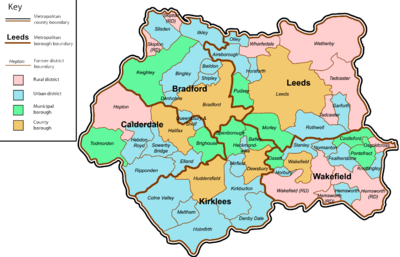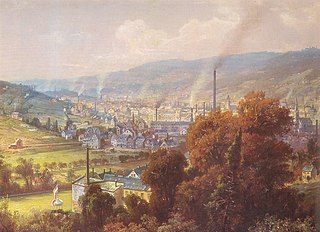
This is a list of the wool, cotton and other textile mills in Wakefield: including Castleford, Ossett and Pontefract.

This is a list of the wool, cotton and other textile mills in Wakefield: including Castleford, Ossett and Pontefract.
| Name | Architect | Location | Built | Demolished | Served (Years) |
|---|---|---|---|---|---|
| Alverthorpe Mills | Alverthorpe With Thornes (Wakefield), SE 3090 2140 53°41′17″N1°32′01″W / 53.68813°N 1.53358°W [1] | ||||
| Notes: National Building Register:63624: [Mill 1] (A) | |||||
| Balne Lane Mills | Alverthorpe With Thornes (Wakefield), SE 3215 2135 53°41′15″N1°30′53″W / 53.68760°N 1.51466°W [1] | ||||
| Notes: National Building Register:63628: [Mill 2] (B) | |||||
| Balne Mill | Alverthorpe With Thornes (Wakefield), | ||||
| Notes: (see Balne Lane Mills) | |||||
| Bective Mills | Alverthorpe With Thornes (Wakefield), SE 310 211 53°41′08″N1°31′56″W / 53.68542°N 1.53210°W [1] | ||||
| Notes: National Building Register:63627: [Mill 3] (C) | |||||
| Calder Dyeworks | Alverthorpe With Thornes (Wakefield), SE 327 187 53°39′50″N1°30′24″W / 53.66375°N 1.50661°W [1] | ||||
| Notes: National Building Register:63767: [Mill 4] (C) | |||||
| Clarkson's Mill | Alverthorpe With Thornes (Wakefield), SE 3208 2055 53°40′50″N1°30′57″W / 53.68042°N 1.51580°W [1] | ||||
| Notes: National Building Register:63629: [Mill 5] (B) | |||||
| Flanshaw Mill | Alverthorpe With Thornes (Wakefield), SE 3080 2095 53°41′03″N1°32′07″W / 53.68409°N 1.53514°W [1] | ||||
| Notes: National Building Register:63625: [Mill 6] (A) | |||||
| Hebble Mill | Alverthorpe With Thornes (Wakefield), | ||||
| Notes: (see Bective Mills) | |||||
| Oakes Mill | Alverthorpe With Thornes (Wakefield), | ||||
| Notes: (see Flanshaw Mill) | |||||
| Portobello Mills | Alverthorpe With Thornes (Wakefield), SE 335 195 53°40′15″N1°29′40″W / 53.67089°N 1.49442°W [1] | ||||
| Notes: National Building Register:63768: [Mill 7] (C) | |||||
| Thornes Mill | Alverthorpe With Thornes (Wakefield), SE 327 190 53°39′59″N1°30′24″W / 53.66645°N 1.50658°W [1] | ||||
| Notes: National Building Register:63766: [Mill 8] (C) | |||||
| West Riding Mills | Alverthorpe With Thornes (Wakefield), | ||||
| Notes: (see Calder Dyeworks) | |||||
| Westgate Common Mill | Alverthorpe With Thornes (Wakefield), | ||||
| Notes: (see C1arkson's Mill) | |||||
| Name | Architect | Location | Built | Demolished | Served (Years) |
|---|---|---|---|---|---|
| Addingford Mills | Horbury, SE 2915 1767 53°39′17″N1°33′38″W / 53.65470°N 1.56043°W [2] | ||||
| Notes: National Building Register:63764: [Mill 9] (B) | |||||
| Albert Mill | Horbury, SE 2875 1792 53°39′25″N1°33′59″W / 53.65697°N 1.56646°W [2] | ||||
| Notes: National Building Register:63760: [Mill 10] (B) | |||||
| Albion Mills | Horbury, SE 2845 1799 53°39′27″N1°34′16″W / 53.65762°N 1.57099°W [2] | ||||
| Notes: National Building Register:63757: [Mill 11] (B) | |||||
| Dudfleet Mill | Horbury, SE 2995 1735 53°39′06″N1°32′54″W / 53.65178°N 1.54835°W [2] | ||||
| Notes: National Building Register:63765: [Mill 12] (B) | |||||
| Ford Mill | Horbury, SE 2872 1798 53°39′27″N1°34′01″W / 53.65751°N 1.56690°W [2] | ||||
| Notes: National Building Register:63759: [Mill 13] (B) | |||||
| Horbury Bridge Mill | Horbury, SE 2789 1820 53°39′34″N1°34′46″W / 53.65953°N 1.57944°W [2] | ||||
| Notes: National Building Register:63752: [Mill 14] (B) | |||||
| Manor Mills | Horbury, SE 2890 1930 53°40′10″N1°33′51″W / 53.66937°N 1.56406°W [2] | ||||
| Notes: National Building Register:63756: [Mill 15] (C) | |||||
| Navigation Mill | Horbury, SE 2815 1798 53°39′27″N1°34′32″W / 53.65754°N 1.57553°W [2] | ||||
| Notes: National Building Register:63771: [Mill 16] (B) | |||||
| New Mill | Horbury, | ||||
| Notes: (see Horbury Bridge Mill) | |||||
| Peel Mills | Horbury, SE 2942 1809 53°39′30″N1°33′23″W / 53.65846°N 1.55630°W [2] | ||||
| Notes: National Building Register:63763: [Mill 17] (B) | |||||
| Terry Mills | Horbury, SE 2885 1860 53°39′47″N1°33′54″W / 53.66308°N 1.56488°W [2] | ||||
| Notes: National Building Register:63773: [Mill 18] (B) | |||||
| Victoria Mill | Horbury, SE 2850 1797 53°39′27″N1°34′13″W / 53.65743°N 1.57023°W [2] | ||||
| Notes: National Building Register:63758: [Mill 19] (B) | |||||
| Name | Architect | Location | Built | Demolished | Served (Years) |
|---|---|---|---|---|---|
| Stanley Mills | Stanley Cum Wrenthorpe (Stanley), SE 3408 2472 53°43′04″N1°29′06″W / 53.71777°N 1.48507°W [3] | ||||
| Notes: National Building Register:63632: [Mill 20] (B) | |||||
| Name | Architect | Location | Built | Demolished | Served (Years) |
|---|---|---|---|---|---|
| Albion Mills | Wakefield, SE 3275 2050 53°40′48″N1°30′20″W / 53.67992°N 1.50566°W [4] | ||||
| Notes: National Building Register:63630: [Mill 21] (B) | |||||
| Castle Bank Mill | Wakefield, SE 3375 1940 53°40′12″N1°29′26″W / 53.66997°N 1.49064°W [4] | ||||
| Notes: National Building Register:63769: [Mill 22] (B) | |||||
| Chald Mill | Wakefield, SE 3 2 53°40′32″N1°32′50″W / 53.67560°N 1.54734°W [4] | ||||
| Notes: National Building Register:63663: [Mill 23] (C) | |||||
| Providence Mills | Wakefield, SE 3265 2040 53°40′45″N1°30′26″W / 53.67903°N 1.50719°W [4] | ||||
| Notes: National Building Register:63631: [Mill 24] (B) | |||||
| Westgate New Mills | Wakefield, SE 3 2 53°40′32″N1°32′50″W / 53.67560°N 1.54734°W [4] | ||||
| Notes: National Building Register:63665: [Mill 25] (C) | |||||
| Whiteoak Mills | Wakefield, | ||||
| Notes: (see Providence Mills) | |||||

Carding is a mechanical process that disentangles, cleans and intermixes fibres to produce a continuous web or sliver suitable for subsequent processing. This is achieved by passing the fibres between differentially moving surfaces covered with "card clothing", a firm flexible material embedded with metal pins. It breaks up locks and unorganised clumps of fibre and then aligns the individual fibres to be parallel with each other. In preparing wool fibre for spinning, carding is the step that comes after teasing.
A mill town, also known as factory town or mill village, is typically a settlement that developed around one or more mills or factories, usually cotton mills or factories producing textiles.

Flannel is a soft woven fabric, of varying fineness. Flannel was originally made from carded wool or worsted yarn, but is now often made from either wool, cotton, or synthetic fiber. Flannel is commonly used to make tartan clothing, blankets, bed sheets, and sleepwear.

Textile manufacture during the British Industrial Revolution was centred in south Lancashire and the towns on both sides of the Pennines in the United Kingdom. The main drivers of the Industrial Revolution were textile manufacturing, iron founding, steam power, oil drilling, the discovery of electricity and its many industrial applications, the telegraph and many others. Railroads, steamboats, the telegraph and other innovations massively increased worker productivity and raised standards of living by greatly reducing time spent during travel, transportation and communications.

The textile industry is primarily concerned with the design, production and distribution of textiles: yarn, cloth and clothing. The raw material may be natural, or synthetic using products of the chemical industry.

Marshall's Mill is a former flax spinning mill on Marshall Street in Holbeck, Leeds, West Yorkshire, England.
Decatising or decatizing, also known as crabbing, blowing, and decating, is the process of making permanent a textile finish on a cloth, so that it does not shrink during garment making. The word comes from the French décatir, which means to remove the cati or finish of the wool. Though used mainly for wool, the term is also applied to processes performed on fabrics of other fibers, such as cotton, linen or polyester. Crabbing and blowing are minor variations on the general process for wool, which is to roll the cloth onto a roller and blow steam through it.

Arkwright Mill, Rochdale is a cotton spinning mill in Rochdale, Greater Manchester. It was built in 1885 by the Arkwright Cotton Spinning Co. It was taken over by the Lancashire Cotton Corporation in the 1930s and passed to Courtaulds in 1964. It was located next to Dale Mill on Roch Street. The ring and doubling frames were made by Howard & Bullough, Accrington. The mill closed in 1980, was demolished in 2007 and the land redeveloped for housing.

Gayle Mill, dating from about 1784, is thought to be the oldest structurally unaltered cotton mill in existence. It is located in the Wensleydale hamlet of Gayle, England, 1 mile (2 km) south of the market town of Hawes. It lies within the Yorkshire Dales National Park. The mill is owned by Cultura Trust (formerly known as the North of England Civic Trust ; it was operated by a local volunteer group which paid a modest rent to the owner until March 2018 when the property was closed to enable additional repairs to be undertaken to make it safe for visitors.

The woollen industry in Wales was at times the country's most important industry, though it often struggled to compete with the better-funded woollen mills in the north of England, and almost disappeared during the 20th century. There is continued demand for quality Welsh woollen products.
The National Monument Record is a legacy numbering system maintained by English Heritage. Further details on each mill may be obtained from http://yorkshire.u08.eu/